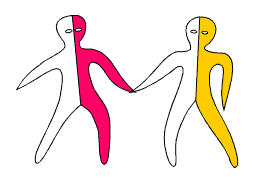Download This Content
APoGI for the Haemoglobin Disorders
![]()
Download This Content ![]()
This couple could have a child with haemoglobin S/O Arab disorder.
| Partner who carries haemoglobin S |  |
Partner who carries haemoglobin O Arab | |
 |
 |
 |
 |
| Not a carrier | Carrier of haemoglobin S | Carrier of haemoglobin O Arab | Child with haemoglobin S/O Arab disorder |
In each pregnancy, there are four possibilities:
In each pregnancy there is a 3 out of 4 chance of a healthy child, and a 1 out of 4 chance of child with haemoglobin S/O Arab disorder.
...is a sickle cell disorder. It is rare, and we are not able to describe it with complete confidence. It is generally thought to be a mild type of sickle cell disorder. Children with a sickle cell disorder have an increased risk of serious infections, and need to take antibiotics daily. Some people with haemoglobin S/O Arab disorder are completely healthy all their life. Some are anaemic, and have attacks of severe pain in joints or other parts of the body from time to time. A few have severe health problems and need frequent admissions to hospital. People with haemoglobin S/O Arab disorder should attend a sickle cell clinic regularly for a check-up and advice.
At present, it is not possible to predict whether a particular couple could have children with mild, moderate or severe haemoglobin S/O Arab disorder.
It is possible to test a baby for Haemoglobin S/O Arab disorder early in pregnancy. This couple should see an expert counsellor in haemoglobin disorders to discuss their options. They should do this before starting a pregnancy, or as early in pregnancy as possible.
![]()
![]() Adobe Acrobat format (PDF) in colour and black-and-white
Adobe Acrobat format (PDF) in colour and black-and-white
![]() Microsoft Rich Text Format in colour and black-and-white
Microsoft Rich Text Format in colour and black-and-white
![]()
These documents are part of the APoGI May 1998 (Evaluation) Release and are made available subject to the APoGI Disclaimers covering usage, distribution and copying.
Problems or further enquiries to APoGI@chime.ucl.ac.uk or the APoGI Contacts
Copyright © 1984 -1998 UCL Medical School. All rights reserved.